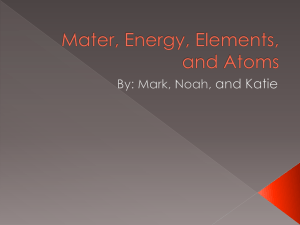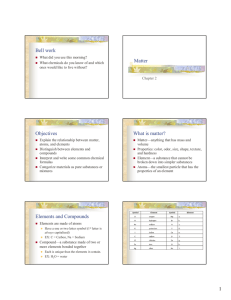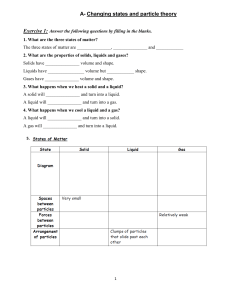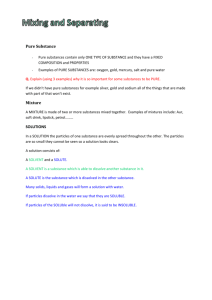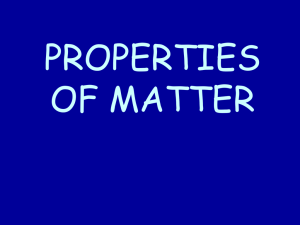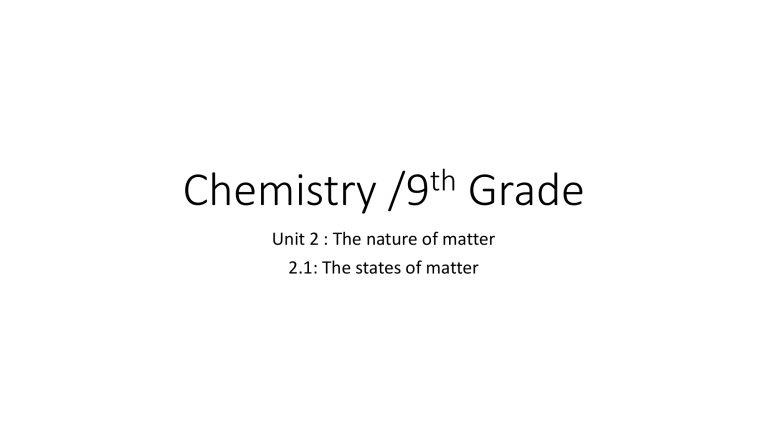
Chemistry th /9 Grade Unit 2 : The nature of matter 2.1: The states of matter 1.1.The states of matter /page 21 • Key definition :Matter : anything that has mass and takes up space • There are 3 physical states : solid ,liquid and gas Table 2.1:Differences in the properties of the 3 states of matter Physical state volume Density shape Fluidity solid Has a fixed volume high Has a definite shape Does not flow Liquid Has a fixed volume Moderate to high No definite shapetakes the shape of the container Generally flows easily gas No fixed volumeexpands to fill the container Low No definite shape – takes the shape of the container Flows easily Solids • Strong forces of attraction between particles, particles are packed very closely together in a fixed and regular pattern • Atoms vibrate in position but can’t change position or move • Solids have a fixed volume, shape and high density Liquids • Weaker attractive forces in liquids than in solids, particles are close together in an irregular, unfixed • Particles can move and slide past each other which is why liquids adopt the shape of the container they’re in and also why they are able to flow • Liquids have a fixed volume but not a fixed shape and have a moderate to high density Gases • No intermolecular forces, particles are in random movement and so there is no defined pattern • Particles are far apart and move quickly (around 500 m/s) in all directions, they collide with each other and with the sides of the container (this is how pressure is created inside a can of gas) • No fixed volume, since there is a lot of space between the particles, gases can be compressed into a much smaller volume. Gases have low density Changes in physical state Sublimation :a few solids change directly from solid to gas on heating;the term sublimation is used for the change in either direction Evaporation and condensation take place over a range of temperature ,boiling takes place at a specific temperature Melting :a pure substance melts suddenly at a particular temp Freezing:the reverse takes place sharply at the same temp Interconversion of solids, liquids and gases Melting • Melting is when a solid changes into a liquid • Requires heat energy which transforms into kinetic energy, allowing the particles to move • Occurs at a specific temperature known as the melting point (m.p.) which is unique to each pure solid Boiling • Boiling is when a liquid changes into a gas • Requires heat which causes bubbles of gas to form below the surface of a liquid, allowing for liquid particles to escape from the surface and within the liquid • Occurs at a specific temperature known as the boiling point (b.p.) which is unique to each pure liquid Freezing • Freezing is when a liquid changes into a solid • This is the reverse of melting and occurs at exactly the same temperature as melting, hence the melting point and freezing point of a pure substance are the same. Water for example freezes and melts at 0ºC • Requires a significant decrease in temperature (or loss of thermal energy) and occurs at a specific temperature which is unique for each pure substance Evaporation • When a liquid changes into a gas. Evaporation occurs only at the surface of liquids where high energy particles can escape from the liquid’s surface at low temperatures, below the b.p. of the liquid • The larger the surface area and the warmer the liquid/surface, the more quickly a liquid can evaporate • No heat is required and evaporation occurs over a range of temperatures Condensation • When a gas changes into a liquid, usually on cooling. When a gas is cooled its particles lose energy and when they bump into each other, they lack energy to bounce away again, instead grouping together to form a liquid • No energy is required for condensation to occur and it takes place over a range of temperatures sublimation • When a solid changes directly into a gas • This happens to only a few solids such as iodine or solid carbon dioxide • The reverse reaction also happens and is also called sublimation (sometimes called deposition or desublimation) • Sublimation occurs at a specific temperature which is unique for a pure substance Gaseous Particles •Gaseous particles are in constant and random motion •An increase in temperature increases the kinetic energy of each particle, as the thermal energy is transformed to kinetic energy, so they move faster •Decreasing the temperature has the opposite effect •The pressure that a gas creates inside a closed container is produced by the gaseous particles hitting the inside walls of the container. As the temperature increases, the particles in the gas move faster, impacting the containers walls more frequently •Therefore an increase in temperature causes an increase in pressure Moving particles of gas colliding with each other an the container walls Video • https://lab.concord.org/embeddable.html#interactives/sam/diffusion/3-mass.json Volatility : is the tendency of a substance to vaporize • A volatile liquid is one which evaporates easily and has a relatively low b.p • Ethanol(b.p 78C) is a more volatile liquid than water(b.p 100C ) • B.p : when vapor pressure = atmospheric pressure • https://www.youtube.com/watch?v=dx4XOYpj1_k B.p The heating curve Cooling curve Assessing Purity • Pure substances melt and boil at specific and sharp temperatures. Eg water has a boiling point of 100°C and a melting point of 0°C • Mixtures have a range of melting and boiling points as they consist of different substances that melt or boil at different temperatures • Melting and boiling points data can therefore be used to distinguish pure substances from mixtures • An unknown pure substance can be identified by experimentally determining its m.p and b.p and comparing to data tables • Mixtures melt over a range of temperatures as they contain two or more substances Importance of Purity • A pure substance consists of only one substance and contains nothing else. • To have a pure substance for food and drugs is very important as impurities could be dangerous even in small amounts • Melting and boiling point analysis is routinely used to assess the purity of food and drugs • For example, if a sample of water melts at exactly 0°C and boils at exactly 100°C then the water is pure • If the melting and boiling points of the water aren’t these exact values then the water must be impure and contain other substances i.e. it must be a mixture The effect of impurities • The presence of an impurity in a substance : • 1-lowers the melting point • 2-raises the boiling point of the substance • Seawater freezes at a temp well below the freezing point of pure water H.W • Answer questions page 27 Separating and purifying substances/Page:27 • The most useful separation method for a particular mixture depends on : • 1-The type of mixture • 2-which substance in the mixture we are most interested in 2.2.Separation and purifying substances Page :28 Mixture Method of separation Solid + solid (powdered mixture) Use some difference in properties ,e.g. density, solubility, sublimation, magnetism Suspension of solid in liquid Filtration or centrifugation Liquid + liquid (immiscible) Use a separating funnel or decantation Solution of solid in liquid To obtain solid :use evaporation(crystallization)to obtain liquid: use distillation Two (or more )liquids mixed together(miscible) Fractional distillation Solution of two(or more) solids in a liquid Chromatography Separating Funnel video • https://www.youtube.com/watch?v=WSdGxQBnhZU Crystallisation • Used to separate a dissolved solid from a solution, when the solid is much more soluble in hot solvent than in cold (e.g. copper sulphate from a solution of copper (II) sulphate in water) • The solution is heated, allowing the solvent to evaporate to leave a saturated solution behind • Test if the solution is saturated by dipping a clean, dry, cold glass rod into the solution. If the solution is saturated, crystals will form on the glass rod • The saturated solution is allowed to cool slowly and solids will come out of the solution as the solubility decreases, and crystals will grow • Crystals are collected by filtering the solution • They are then washed with cold, distilled water to remove impurities and allowed to dry Glass rod Video • https://www.youtube.com/watch?v=vi_SJBnxmHo Simple Distillation •Used to separate a liquid and soluble solid from a solution (e.g. water from a solution of saltwater) or a pure liquid from a mixture of liquids •The solution is heated and pure water evaporates producing a vapor which rises through the neck of the round-bottomed flask •The vapor passes through the condenser, where it cools and condenses, turning into pure liquid H2O which is collected in a beaker •After all the water is evaporated from the solution, only the solid solute will be left behind Video • https://www.youtube.com/watch?v=eQlnHr9g6Io Video • https://www.youtube.com/watch?v=eQlnHr9g6Io Paper Chromatography • This technique is used to separate substances that have different solubilities in a given solvent (e.g. different coloured inks that have been mixed to make black ink) • A pencil line is drawn on chromatography paper and spots of the sample are placed on it. Pencil is used for this as ink would run into the chromatogram along with the samples • The paper is then lowered into the solvent container, making sure that the pencil line sits above the level of the solvent so the samples don´t wash into the solvent container • The solvent travels up the paper by capillary action, taking some of the coloured substances with it • Different substances have different solubilities so will travel at different rates, causing the substances to spread apart. Those substances with higher solubility will travel further than the others • This will show the different components of the ink / dye Analysis of the composition of ink using paper chromatography Analysis of the composition of ink using paper chromatography Analysis of the composition of ink using paper chromatography Interpret Simple Chromatograms • If two or more substances are the same, they will produce identical chromatograms • If the substance is a mixture, it will separate on the paper to show all the different components as separate spots • An impure substance will show up with more than one spot, a pure substance should only show up with one spot Retention Factor (Rf) Values • These values are used to identify the components of mixtures • The Rf value of a particular compound is always the same • Calculating the Rf value allows chemists to identify unknown substances because it can be compared with Rf values of known substances under the same conditions Calculation • Retention factor = distance moved by compound ÷ distance moved by solvent • The Rf value is a ratio and therefore has no units Video • https://www.youtube.com/watch?v=TdJ57SQ6GAQ Video • https://www.onlinemathlearning.com/chromatography.html Questions • Questions 1. Why should the line at the bottom of the paper be drawn in pencil? 2. What would happen if the level of the solvent came above the level of the spots at the start? 3. Why should the solvent not be run off the top of the paper? Answers • 1. We use a pencil because it does not dissolve or smear when the solvent rises past the line 2. If the solvent started above the samples, the sample spots will simply dissolve and will not move up the paper. 3. If the solvent ran off the top of the paper, we will not be able to measure the solvent front which is needed to calculate the Rf values. Video :Calculating the Rf value • https://www.youtube.com/watch?v=nTqiKUcIMfc Question : Calculating the Rf value H.W • Questions page 34 2.3 Atoms and molecules Example Pure substance: • Contains only one substance, with no other substances mixed together • Has fixed melting and boiling point as they consist of only one substance so all molecules will have the same melting and boiling points • E.g. Water has a boiling point of 100°C and a melting point of 0°C Mixture: • A combination of two or more substances (elements and/or compounds) that are not chemically joined together • Has a range of melting and boiling points as they consist of different substances that melt or boil at different temperatures Testing purity: • The physical property of boiling/melting point can therefore be used to test if a substance is pure or not. • For example, if a sample of water melts at exactly 0°C and boils at exactly 100°C then the water is pure. • If the melting and boiling points of the water aren’t these exact values then the water must be impure and contain other substances i.e. it must be a mixture. Brownian motion • Brownian motion is defined as the random movement of particles in a liquid or a gas produced by large numbers of collisions with smaller, often invisible particles • The observation of Brownian motion proves the correctness of the kinetic particle theory • Video: • https://www.youtube.com/watch?v=ZKWesMLciNs Diffusion • This is the process by which different gases or different liquids mix and is due to the random motion of their particles • Diffusing particles move from an area of high concentration to an area of low concentration • Eventually the concentration of particles is even as they spread out to occupy all of the available space • Diffusion happens on its own and no energy input is required although it occurs faster at higher temperatures Changes in State & Kinetic Theory • When substances are heated, the particles absorb thermal energy which is converted into kinetic energy. This is the basis of the kinetic theory of matter • Heating a solid causes its particles to vibrate more and as the temperature increases, they vibrate so much that the solid expands until the structure breaks and the solid melts • On further heating, the now liquid substance expands more and some particles at the surface gain sufficient energy to overcome the intermolecular forces and evaporate • When the b.p. temperature is reached, all the particles gain enough energy to escape and the liquids boils • These changes in state can be shown on a graph which is called a heating curve • Cooling down a gas has the reverse effect and this would be called a cooling curve • These curves are used to show how changes in temperature affect changes of state Heating & cooling curve for water with interconversions of state Diffusion & Molecular Mass • Diffusion occurs much faster in gases than in liquids as gaseous particles move much quicker than liquid particles • At the same temperature, different gases do not diffuse at the same rate. • This is due to the difference in their relative molecular masses • Lighter gas particles can travel faster and hence further, therefore the lower its relative mass the faster a gas will diffuse NH3 molecules have less mass than the HCl molecule, so diffuse faster, hence the product (a white cloud of NH4Cl) forms closer to the end where the HCl is H.W • Questions page 40 2.4 The structure of the atom The Structure of an Atom • Atoms are made up of subatomic particles called protons, neutrons and electrons. • The nucleus is composed of protons and neutrons and the electrons orbit around the nucleus in different shells. A model diagram for an atom is shown below: The Structure of an Atom The Structure of an Atom Atomic number and mass number Atomic number and mass number • The proton number is shown below the chemical symbol, and the mass number is shown above. In this example the atomic number is 17 and the mass number is 35. This means that each of these atoms has: • 17 protons • 17 electrons • 35 - 17 = 18 neutrons Ions • Atoms can lose or gain electrons. When they do, they form charged particles called ions: • if an atom loses one or more electrons, it becomes a positively charged ion • if an atom gains one or more electrons, it becomes a negatively charged ion Video • https://www.youtube.com/watch?v=PCZtnbxtXqE Calculate each of the three subatomic particles? Ions Ions Ions Calculating Relative Atomic Mass • Isotopes: • Atoms of the same element that contains the same number of protons and electrons but different number of neutrons. Example 1: • The table shows information about the isotopes in a sample of Rubidium Answer Example 2: Answer H.W • Questions page 47 2.5 Electron arrangement in atoms • Electrons move around the nucleus in different energy levels. The energy levels are called electron shells. • Electronic configuration: The arrangement of electrons into shells for an atom. This can be figured out by following some rules: • Electrons always occupy shells that are closest to the nucleus first • When a shell becomes full, electrons will fill the next shell Electron arrangement in atoms Electron arrangement in atoms Electron arrangement in atoms main energy levels were split into sub levels. Level 1 was split into 1 sub level Level 2 was split into 2 sub levels Level 3 was split into 3 sub levels Level 4 was split into 4 sub levels Electron arrangement in atoms • An orbital is: a region in space where one is likely to find an electron. • Orbitals can hold up to two electrons Electron arrangement in atoms ORDER OF FILLING ORBITALS ORDER OF FILLING ORBITALS ORDER OF FILLING ORBITALS ORDER OF FILLING ORBITALS P.T Write the electron configuration for the following atoms •H • He • Li • Be •B Write the electron configuration for the following atoms •C •N •O •F • Ne Write the electron configuration for the following atoms • iron • bromine The following electron configurations belong to which elements: • 1) 1s2 2s2 2p6 3s1 • 2) 1s2 2s2 2p6 3s2 3p6 4s2 3d104p6 5s2 4d6 • 3) 1s2 2s2 2p6 3s2 3p6 4s2 3d10 4p6 5s2 4d10 5p5 sodium ruthenium iodine H.W • Questions page 48
